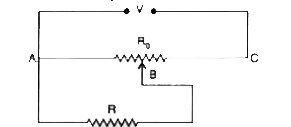An electron is accelerated through a potential difference of 100 volts. What is the de-Broglie wavelength associated with it? To which part of the electromagnetic spectrum does this value of wavelength correspond ?Solution in Kannada
λ=h√2meV or λ=12.27√V Å
λ=12.27√100Å=1.227Å
This wavelength corresponds to the X-rays.
Topper's Solved these Questions
- BOOK - OSWAAL PUBLICATIONCHAPTER - DUAL NATURE OF RADIATION AND MATTEREXERCISE - TOPIC-2 DE-BROGLIE RELATION (SHORT ANSWER TYPE QUESTIONS-II)2videos
DUAL NATURE OF RADIATION AND MATTER
- BOOK - OSWAAL PUBLICATIONCHAPTER - DUAL NATURE OF RADIATION AND MATTEREXERCISE - TOPIC-2 DE-BROGLIE RELATION (LONG ANSWER TYPE QUESTIONS)1videos
DUAL NATURE OF RADIATION AND MATTER
- BOOK - OSWAAL PUBLICATIONCHAPTER - DUAL NATURE OF RADIATION AND MATTEREXERCISE - TOPIC-2 DE-BROGLIE RELATION (VERY SHORT ANSWER TYPE QUESTIONS)8videos
DUAL NATURE OF RADIATION AND MATTER
- BOOK - OSWAAL PUBLICATIONCHAPTER - CURRENT ELECTRICITY EXERCISE - TOPIC-3 (POTENTIOMETER & APPLICATIONS) (NUMERICAL PROBLEMS)2videos
CURRENT ELECTRICITY
- BOOK - OSWAAL PUBLICATIONCHAPTER - ELECTRIC CHARGES & FIELDSEXERCISE - (TOPIC -2)Numerical Problems5videos
ELECTRIC CHARGES & FIELDS
Similar Questions
An electron and a photon each have a wavelength of 1.00 nm. Find (i) their momentum (ii) the energy of the photon and (iii) K.E of electron
03:13View SolutionWhat are matter waves? Derive an expression for the de Broglie wave length.
01:01View SolutionA proton and an electron have same kinetic energy. Which one has smaller de-Broglie wavelength ?
02:13View SolutionA resistance of RΩ draws current from a potentiometer. The potentiometer has a total resistance R0Ω.A voltage V is supplied to the potentiometer. Derive an expression for the voltage across R when the sliding contact is in the middle of the potentiometer.
 06:19View Solution
06:19View SolutionAn atom was earlier assumed to be sphere of radius a having a positively charged point nucleus of charge +Ze at its centre . This nucleus was believed to be surrounded by a uniform desity of negative charge that made the atom neutral as a whole.
Use this theorem to find the electric field of this atom at a distance r(r>a) from the centre of the atom.06:45View SolutionWhat is the de-Broglie wavelength associated with an electron moving with an electron, accelerated through a potential difference of 100 volt?
02:46View SolutionAn electron is accelerated through a potential difference of 100 volts. What is the de-Broglie wavelength associated with it ? To which part of the electromagnetic does this value of wavelength correspond ?
04:11View SolutionWhat is the de Broglie wavelength associated with an electron , accelerated through a potential difference of 100 volts ?
02:46View Solutionएक इलेक्ट्रॉन 100 वोल्ट के विभवांतर द्वारा त्वरित होता है। इससे संबद्ध डी ब्रॉग्ली तरंगदैर्घ्य होगा ? यह तरंगदैर्घ्य विद्युत चुंबकीय स्पेक्ट्रम के किस क्षेत्र के संगत है ?
02:46View Solutionएक इलेक्ट्रॉन 144 वोल्ट के विभवांतर द्वारा त्वरति होता है। इससे संबद्ध दे ब्रॉग्ली तरंगदैर्घ्य क्या होगा ? यह तरंगदैर्घ्य विद्युत चुंबकीय स्पेक्ट्रम के किस क्षेत्र के संगत है ?
01:51View SolutionAn electron is accelerated through a potential difference of 81V. What is the de Broglie wavelength associated with it? To which part of electromagnetic spectrum does this wavelength corresspond ?
03:11View SolutionWhat is the de Broglie wave lenght of an electron, which is accelerated from the rest, through a potential difference of 100 V?
05:43View SolutionAn electron is accelerated through a potential difference of 81V. What is the de Broglie wavelength associated with it? To which part of electromagnetic spectrum does this wavelength corresspond ?
01:43View SolutionAn electron is accelerated through a potential difference of 81V. What is the de Broglie wavelength associated with it? To which part of electromagnetic spectrum does this wavelength corresspond ?
02:01View SolutionWhat is the de Broglie wavelength associated with an electron, accelerated through a potential differnece of 100 volts?
02:40View SolutionWhat is the de-Broglie wavelength associated with an electron moving with an electron, accelerated through a potential difference of 100 volt?
View Solution

